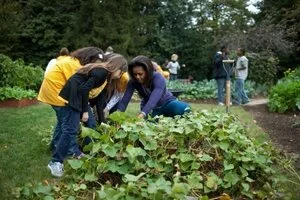Bringing Inspiration and Fresh Produce to Communities
From our archives at eatTV, our James Beard-award winning food video showcase, here’s a bit about our video featuring the White House garden.
There’s a garden growing at the White House, and another in Crown Heights, Brooklyn. Different home bases, with remarkably similar goals: to educate people about the benefits of growing and eating fresh fruits and vegetables. We met up with the organizers of each garden at the IACP Regional NY Conference to learn why gardens are such powerful resources in communities starved for fresh foods.
Nationwide, 2.3 million Americans live in a food desert: they are more than a mile from a supermarket without an easy mode of transportation to get there. Not coincidentally, the neighborhoods that have the least fresh food available are the same neighborhoods where cases of diet-related health problems like diabetes and obesity are high.
Over the past 30 years,obesity rates in the U.S. have tripled, and today, one in three kids is overweight or obese. In African-American and Hispanic neighborhoods, around 40% of all children are overweight. Fresh fruits and vegetables are cornerstones of a healthy diet, but so many Americans don’t take the time, don’t know how to cook, can’t afford or can’t find the fresh produce needed to make a healthy meal.
Sam Kass (White House Assistant Chef & Senior Policy Advisor for Healthy Food Initiatives) worked with Michelle Obama to plant the first kitchen garden on White House grounds since Eleanor Roosevelt built her Victory Garden during WWII. It’s part of the Obama/Kass team effort to battle rising national obesity rates and increase fresh food access through initiatives like Let’s Move! and Chefs Moves to Schools.
More than anything, the garden is a symbol and a conversation starter. Anyone passing by can witness the bounty of kale and lettuces growing in the raised beds, or the green beans climbing up the corn stalks. Local students are invited in to get their hands in the dirt and taste unfamiliar things like kohlrabi and leeks.
Kass claims that when the First Lady goes to international summits, the kitchen garden “is all they want to talk about.” He says that the White House garden is helping to reestablish “a connection that’s been lost,” and that community gardens and school farms are cropping up all over the country.
Like in Crown Heights, Brooklyn, for instance. Stacey Murphy (BK Farmyards) is trying to reestablish a connection to growing and eating fresh foods in a neighborhood where much food comes out of boxes and cans, and where fried chicken and pork rinds are more readily available than apples and oranges.
In the spring of 2010, Murphy helped build the High School for Public Service Youth Farm, a garden less symbolic than it is utilitarian: it’s bringing fresh produce into a neighborhood starving for it. In its first year, over 100 students cultivated ½ an acre to grow more than 50 varieties of produce—foods many of the students had never even tried.
The benefits are startling: some students have lost weight, while others have become vegetarian. All are eating more fresh foods and vegetables, and are introducing new flavors and recipes to their families at home. The produce is sold at a weekly farmers market, where fruits and vegetables sell out immediately, and through a CSA, where community members can buy “shares” in the farm, entitling them to fresh produce every week. In the next two years, the plan is to cultivate twice as much land, growing twice as many fruits and vegetables for their produce-starved neighborhood.
Both the White House kitchen garden and the High School for Public Service Youth Farm are banking on the premise that getting kids excited about growing their own foods, and the deliciousness that comes from eating fresh fruits and vegetables, will help stem the rising tide of obesity and food-related diseases with the next generation. These gardens symbolize the benefits of fresh, unprocessed whole foods, plucked straight from the ground, not out of package.
For more on the White House kitchen garden, check out Obamafoodorama, an exhaustive and entertaining blog covering White House food initiatives (it also include recipes!)
Still photos provided by: BK Farmyards and The White House/ Bodega footage: Ben Sinclair /High School for Public Service footage: Michael O’Brien / food deserts graphic: Slate.com














